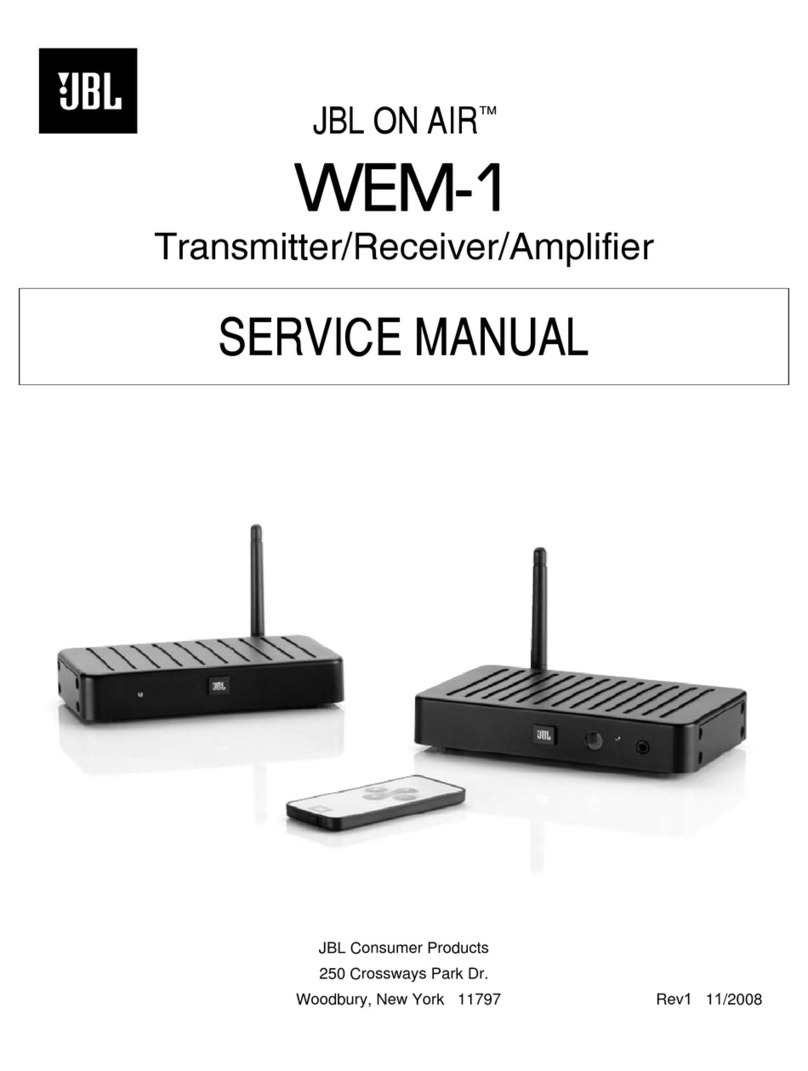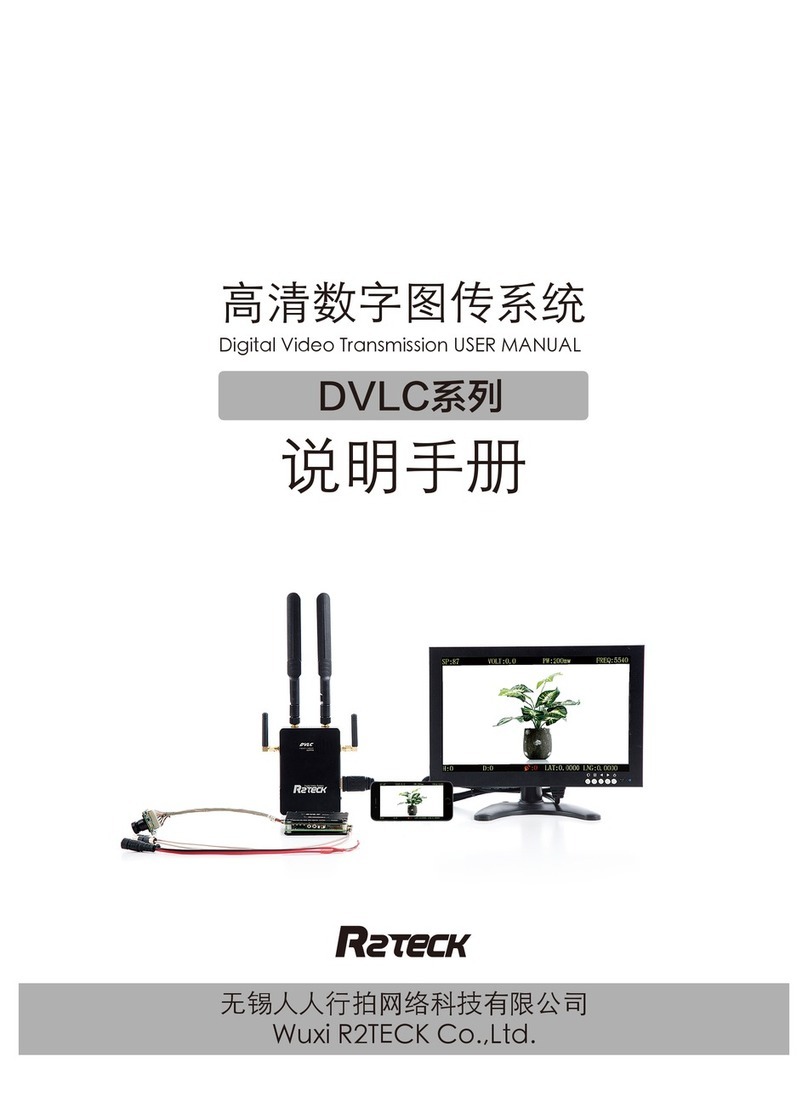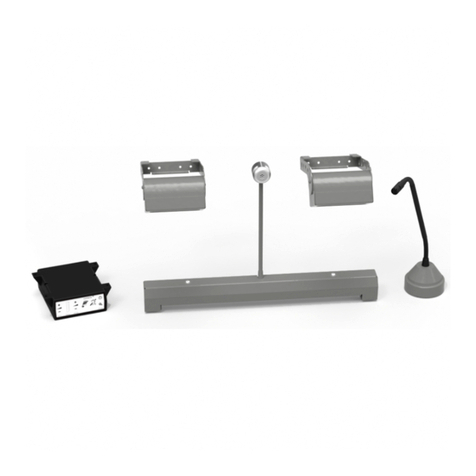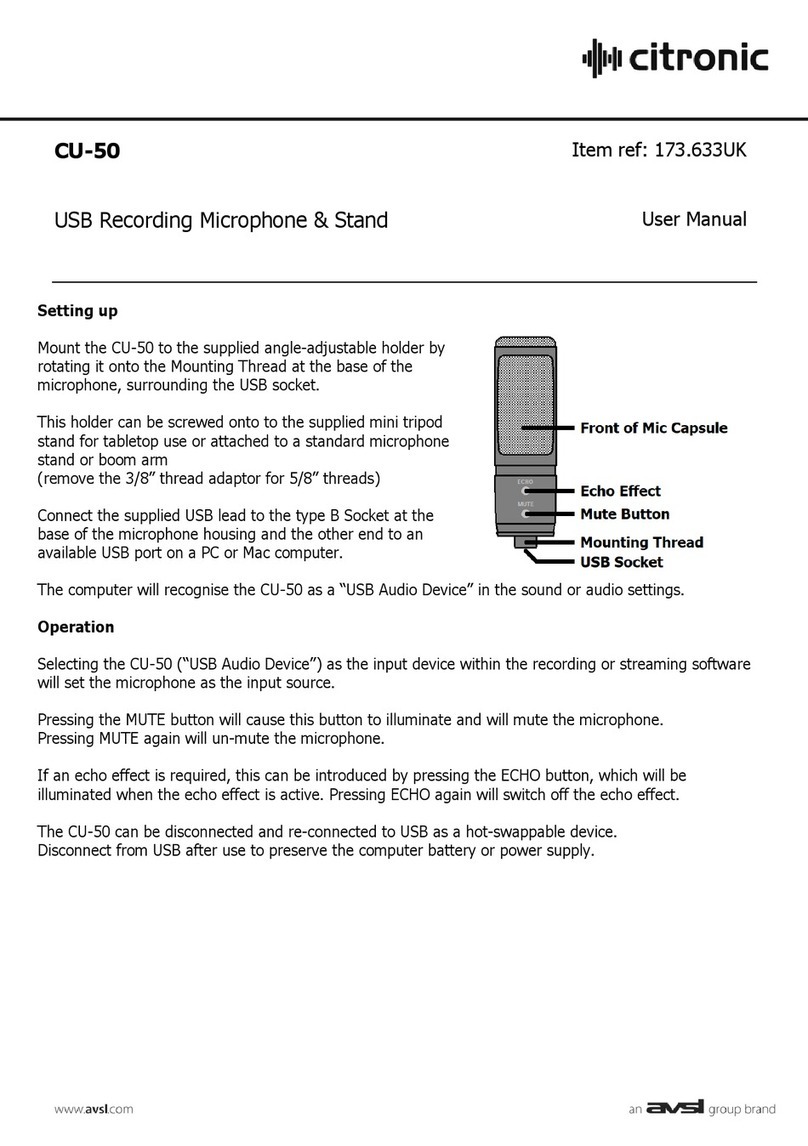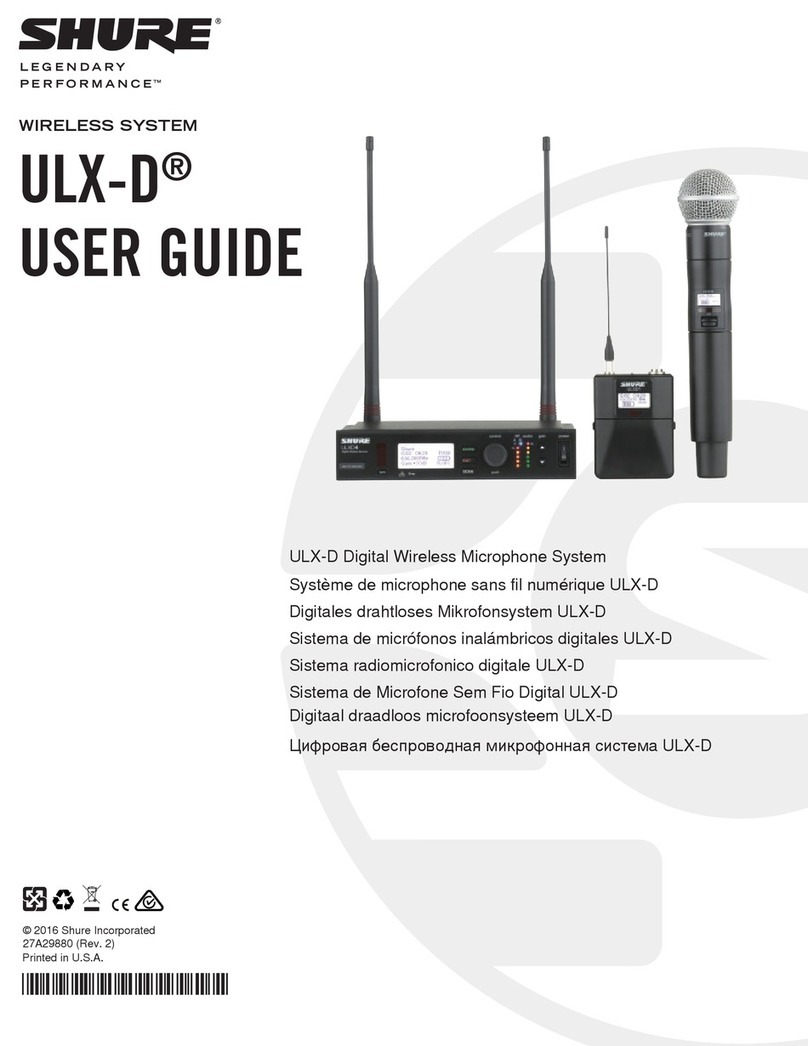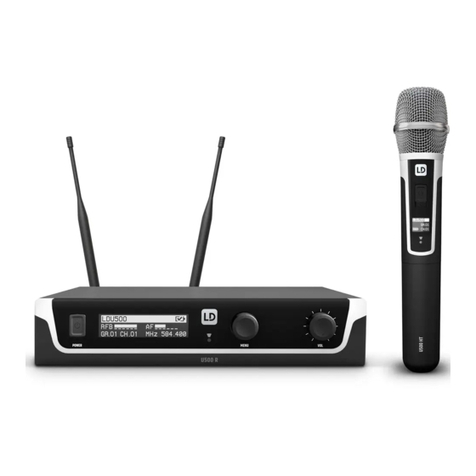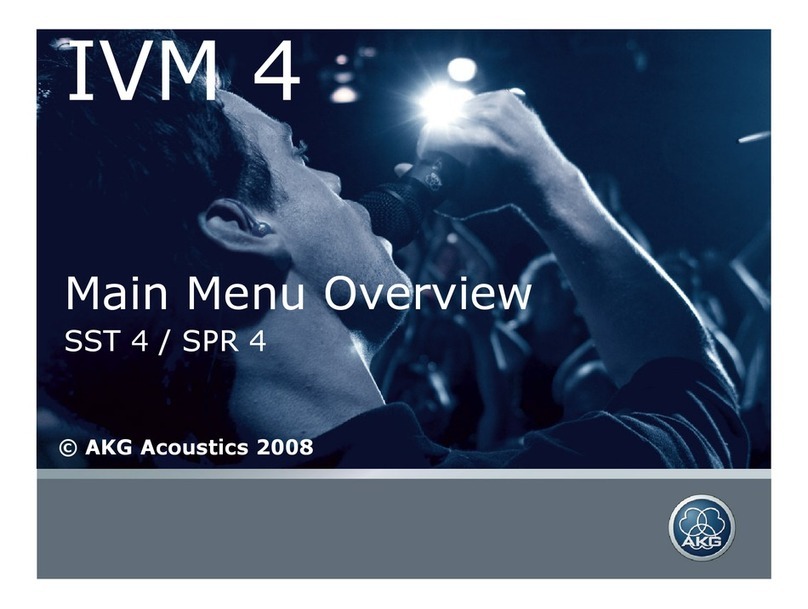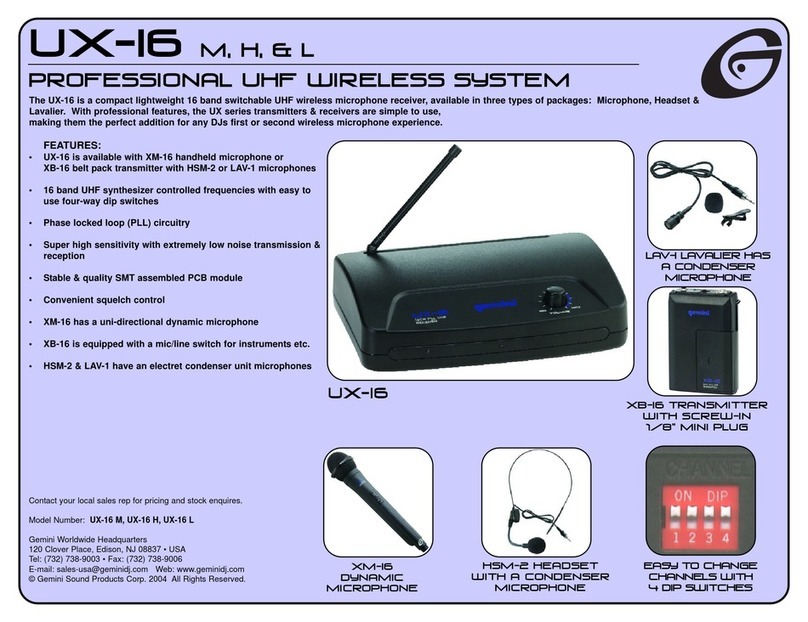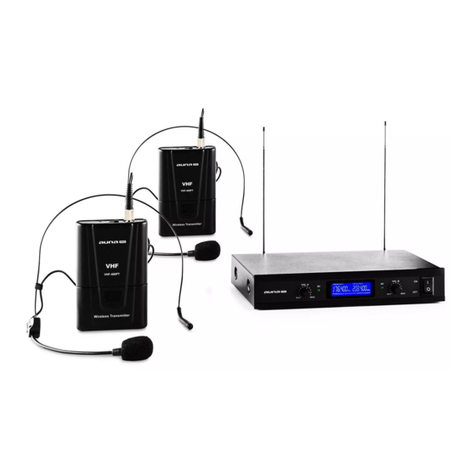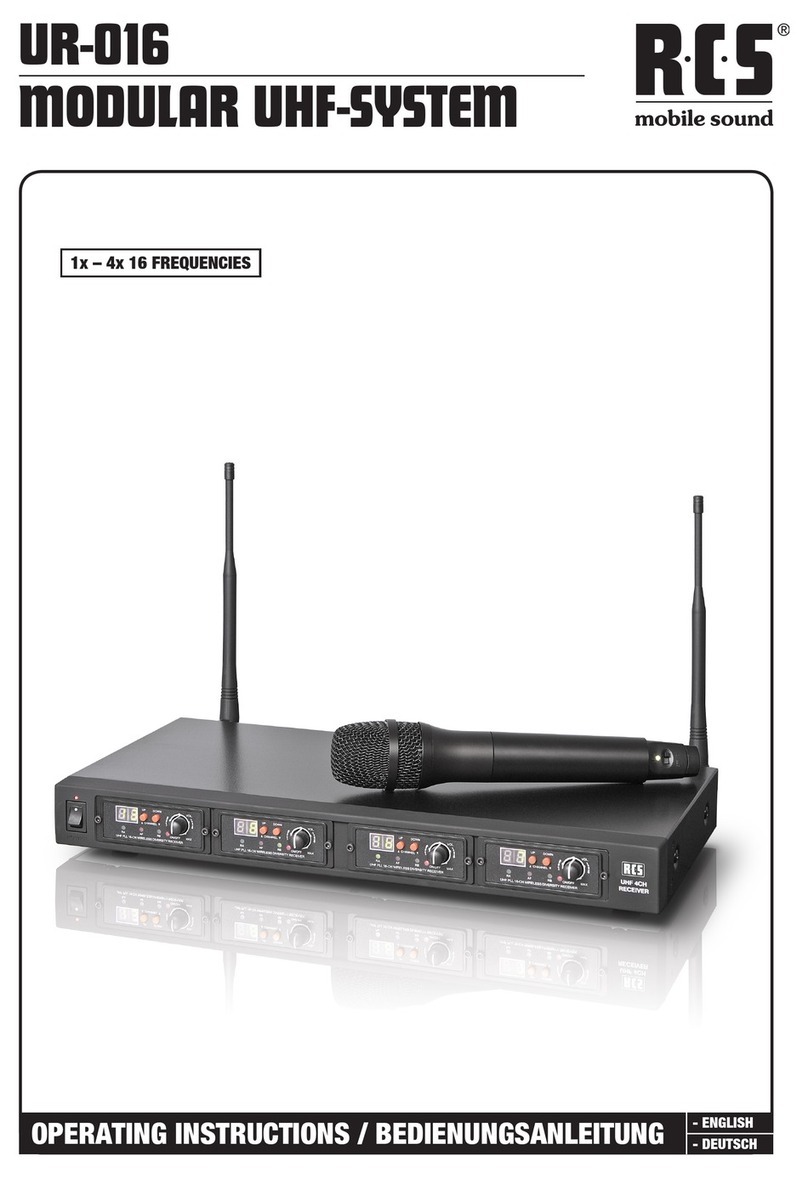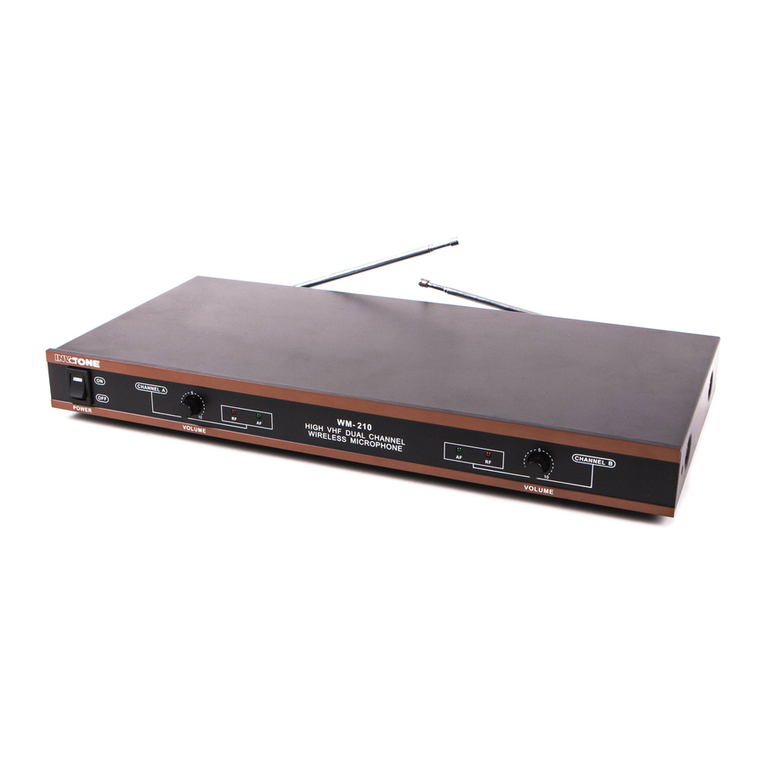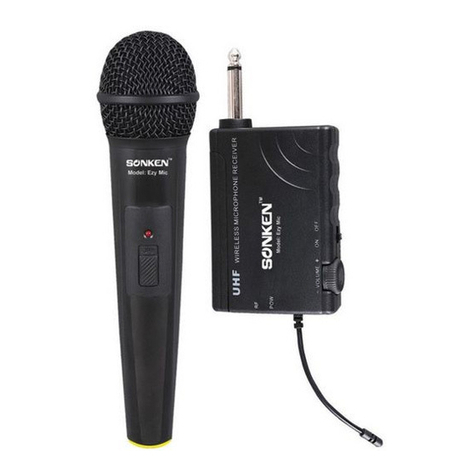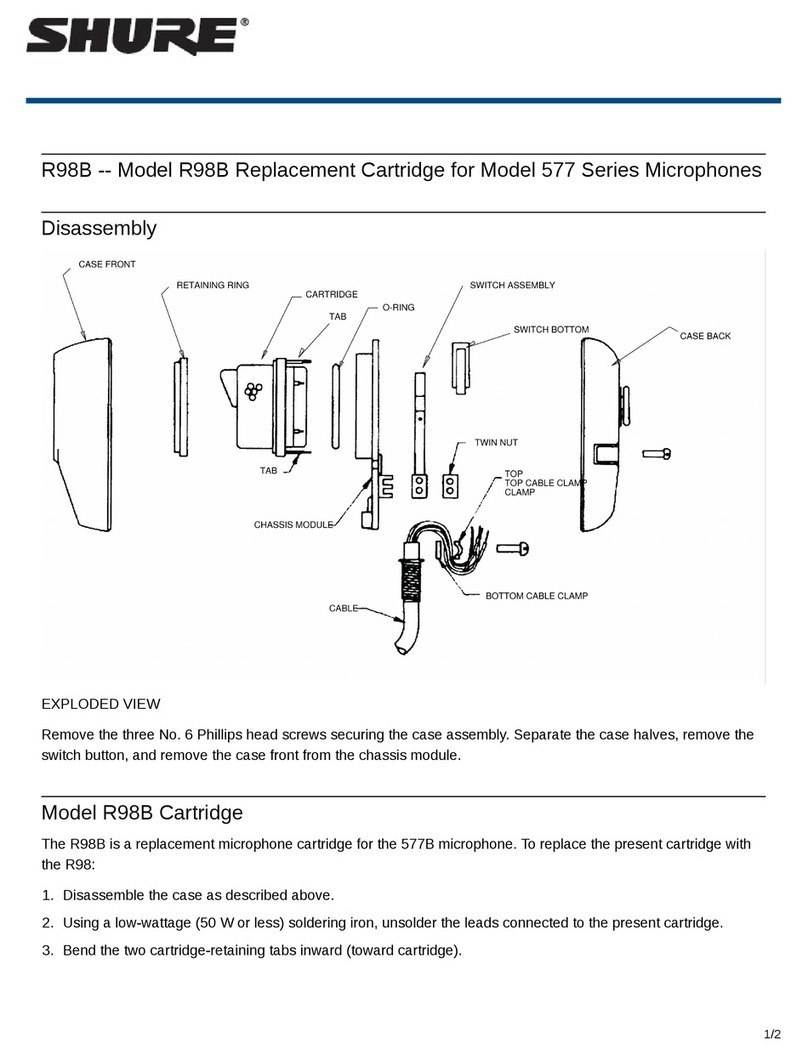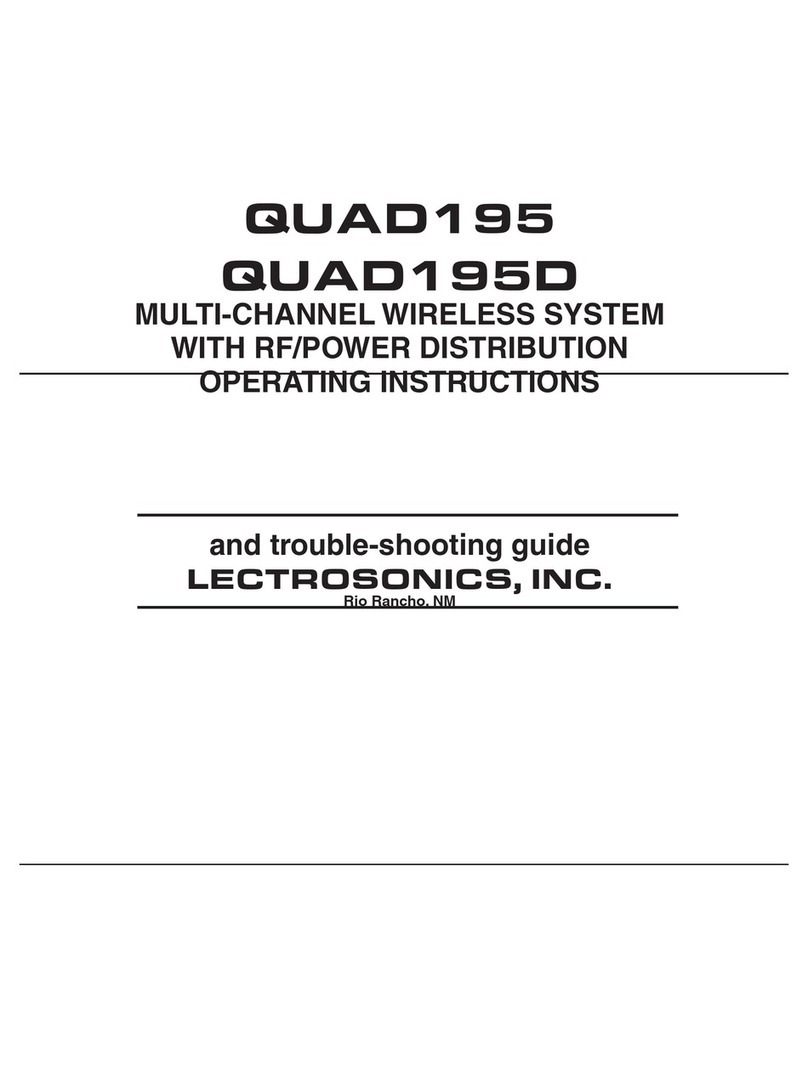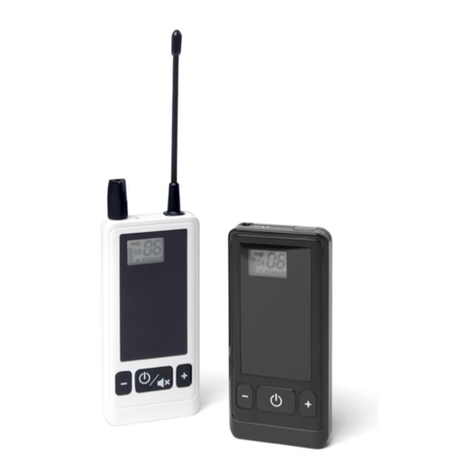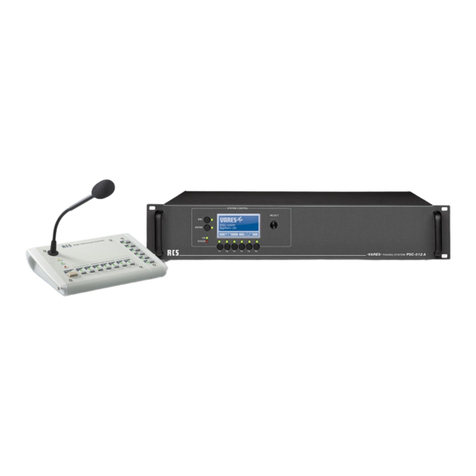JBL On-Air WEM-1 User manual

JBL®ON AIR
WEM-1
OWNER’S
GUIDE
English
0053CSK - JBL OnAir WEM-1 ENG v6:34199_Control_2_4G_Eng 22/08/08 14:27 Side 1

2
IMPORTANT SAFETY
INSTRUCTIONS
This equipment has been tested and found to comply with the limits
for a Class B digital device, pursuant to Part 15 of the FCC Rules.
These limits are designed to provide reasonable protection against
harmful interference in a residential installation.
This equipment generates, uses and can radiate radio frequency
energy and, if not installed and used in accordance with the
instructions, may cause harmful interference to radio
communications. However, there is no guarantee that interference
will not occur in a particular installation. If this equipment does
cause harmful interference to radio or television reception, which
can be determined by turning the equipment off and on, the user is
encouraged to try to correct the interference by one of the
following measures:
• Reorient or relocate the receiving antenna.
• Increase the separation between the equipment and receiver.
• Connect the equipment into an outlet on a circuit different from that
to which the receiver is connected.
• Consult the dealer or an experienced radio/TV technician for help.
FCC Caution: To assure continued compliance, any changes or
modifications not expressly approved by the party responsible for
compliance could void the user's authority to operate this
equipment. (Example - use only shielded interface cables when
connecting to computer or peripheral devices).
FCC Radiation Exposure Statement
This equipment complies with FCC RF radiation exposure limits set
forth for an uncontrolled environment. This equipment should be
installed and operated with a minimum distance of 20 centimeters
between the radiator and your body.
This device complies with Part 15 of the FCC Rules. Operation is subject to the following
two conditions:
(1) This device may not cause harmful interference, and
(2) This device must accept any interference received, including interference that may
cause undesired operation.
FEDERAL COMMUNICATIONS
COMMISSION INTERFERENCE
STATEMENT
1. Read these instructions.
2. Keep these instructions.
3. Heed all warnings.
4. Follow all instructions.
5. Do not use this apparatus near water.
6. Clean only with a dry cloth.
7. Do not block any ventilation openings. Install in accordance with
the manufacturer’s instructions.
8. Do not install near any heat sources such as radiators, heat
registers, stoves or other apparatus (including amplifiers) that
produce heat.
9. Do not defeat the safety purpose of the polarized or grounding-
type plug.
A polarized plug has two blades with one wider than the other. A
grounding-type plug has two blades and a third grounding prong.
The wide blade or the third prong is provided for your safety. If the
provided plug does not fit into your outlet, consult an electrician for
replacement of the obsolete outlet.
10. Protect the power cord from being walked on or pinched,
particularly at plugs, convenience receptacles and the point where
they exit from the apparatus.
11. Only use attachments/accessories specified by the
manufacturer.
12. Use only with the cart, stand, tripod, bracket or table
specified by the manufacturer or sold with the
apparatus. When a cart is used, use caution when
moving the cart/apparatus combination to avoid injury
from tip-over.
13. Unplug this apparatus during lightning storms or when unused for
long periods of time.
14. Refer all servicing to qualified service personnel. Servicing is
required when the apparatus has been damaged in any way, such as
power-supply cord or plug is damaged, liquid has been spilled or
objects have fallen into the apparatus, the apparatus has been
exposed to rain or moisture, does not operate normally, or has been
dropped.
15. Do not expose this apparatus to dripping or splashing and
ensure that no objects filled with liquids, such as vases, are
placed on the apparatus.
16. To completely disconnect this apparatus from the AC Mains,
disconnect the power supply cord plug from the AC receptacle.
17. The mains plug of the power supply cord shall remain readily
operable.
18. Do not expose batteries to excessive heat such as sunshine,
fire or the like.
WARNING: To reduce the risk of fire or electric shock, do not expose this
apparatus to rain or moisture.
0053CSK - JBL OnAir WEM-1 ENG v6:34199_Control_2_4G_Eng 22/08/08 14:27 Side 2

Wireless Transmitter
Wireless Receiver
3
THANK YOU FOR CHOOSING
A JBL®PRODUCT
For more than 60 years, JBL has been involved in every aspect of
music and film recording and reproduction, from live performances
to the recordings you play in your home, car or office.
We’re confident that the JBL system you have chosen will provide
every note of enjoyment that you expected – and that when you think
about purchasing additional audio equipment for your home, car or
office, you will once again choose JBL.
Please take a moment to register your product on our Web site at
www.jbl.com. It enables us to keep you posted on our latest
advance-ments, and helps us to better understand our customers
and build products that meet their needs and expectations.
The JBL®On Air WEM-1 is an advanced wireless system that allows
you to enjoy your favorite music in remote locations around your
home, or to add surround speakers to your home theater system
without running wires to the back of the room. To ensure trouble-free
performance, please carefully read these instructions completely
before connecting or using the system.
UNPACKING THE SYSTEM
Carefully unpack the system. If you suspect damage from transit,
report it immediately to your dealer and/or delivery service.
Keep the shipping carton and packing materials for future use.
Open the package and verify the following contents:
Included
1 x Owner’s manual
1 x USA warranty sheet
1 x Receiver-amplifier module
1 x Power supply for receiver-amplifier
1 x 120V AC power cord for receiver-amplifier power supply
1 x 230V AC power cord for receiver-amplifier power supply –
Schuko plug
1 x 230V AC power cord for receiver-amplifier power supply – UK
plug
1 x Handheld remote control
2 x Wall-mount brackets for receiver
1 x Pedestal – to be attached on receiver’s left side if receiver is
to be used vertically
1 x Transmitter module
1 x Power supply for transmitter
1 x 120V AC power cord for transmitter power supply
1 x 230V AC power cord for transmitter power supply – Schuko
plug
1 x 230V AC power cord for transmitter power supply – UK plug
1 x 6' (1.8m) Audio stereo cable, RCA-RCA
1 x Wall-mount bracket for transmitter
2 x Panhead M3 x 4 machine screws for attaching wall-mount
bracket to transmitter
4 x Small, round, self-adhesive feet – to be attached on
transmitter’s
left-side panel if transmitter is to be used vertically
INPUTMUTE
VOL
Remote Control
Instructions for users on removal and disposal of used batteries.
Specification of included battery types.
These symbols shown on the product, the packaging or in the
manual or separate information
sheet mean that the product itself, as well as the batteries included
or built into the product, should never be thrown away with general
household waste. Take them to applicable collection points, where
proper treatment, recycling and recovery takes place, in
accordance with national or local legislation, or European
Directives 2002/96/EC and 2006/66/EC.
Correct handling of the product and batteries to be disposed helps
saving resources and prevents possible negative effects on the
environment or human health.
The batteries included with your equipment may be Alkaline, Carbon
Zink/Manganese or Lithium (button cells) type. All types should be
disposed of according to the above instructions.
To remove the batteries from your equipment or remote control,
reverse the procedure described for inserting batteries in the
Owners Manual.
For products with a built-in battery that lasts for the lifetime of the
product, removal may not be possible for the user. In this case,
ecycling or recovery centers handle the dismantling of the product
and the removal of the battery. If, for any reason, it becomes
necessary to replace such a battery, this procedure must be
performed by authorized service centers.
Pb
English
0053CSK - JBL OnAir WEM-1 ENG v6:34199_Control_2_4G_Eng 22/08/08 14:27 Side 3

4
WARNING: The minimum load impedance that this
system can handle safely is 4 Ohms. Using lower
impedance loads can damage the unit and will void
your warranty.
Notes: For the sake of simplicity, throughout this manual we have
used the term “source” when describing connections and operation.
This would apply to any device such as an A/V receiver, audio
component, computer or portable music player.
The JBL On Air WEM-1 may be connected to your source in several
ways. First, determine how you would like to use the WEM-1; then
follow the setup instructions for that application.
Audio sources that can be used in this application may be an A/V
receiver or audio receiver, a portable audio player, or a computer
featuring a sound card. First, determine whether your source
contains RCA-type preamp outputs for the front/main channels or
only speaker wire outputs. On an A/V or audio receiver, the preamp
outputs are usually indicated by RCA-type jacks on the back of the
receiver labeled as “pre-out” (please refer to your source’s owner’s
manual to confirm whether it includes preamp outputs). If your
source includes these RCA-type outputs, follow the steps in
Connection Option A.
If your source features only speaker wire outputs, follow steps in
Connection Option B. If your receiver does not feature either type of
outputs for the front/main channels, it cannot be used with the
WEM-1.
Connection Option A
Connecting using the preamp outputs on your source:
NOTE: Make sure the power is turned off on all components.
Step 1.
Connect the interconnect cable (included) to the left and right
front/main preamp outputs, zone 2 outputs or REC outputs, and the
inputs on the transmitter module , as shown in Figure 1.
Figure 1.
Step 2.
Place the receiver module in the desired location in your home near
an AC outlet, as it needs to plug into the wall.
Step 3.
Connect speaker wire (not included) to the push terminals on the
receiver module and to the connectors on your speakers, as
shown in Figure 2. Please note that speaker wire features some
form of a polarity indicator to help distinguish its two conductors.
Use this polarity indicator to ensure that you are connecting the
positive (+) terminal on one speaker to the positive (+) terminal on
the other, and the negative (–) to the negative (–).
CONNECTIONS
Figure 2.
Step 4.
Plug the transmitter module and receiver module into the wall
outlets, using the power supply and correct power cord. Make sure
the antennas are extended upward.
Step 5.
Make sure the ID Code setting on the transmitter is set to the
same setting as that on the receiver . See page 5 for more
information on ID codes. If necessary, configure your receiver to
activate the preamp level outputs for the main/front channels
(consult your source’s owner’s manual for specific instructions).
When connected properly, the LED on the front of the receiver
should be red when first plugged in. When a button on the remote is
pressed, the LED should flash green until the transmitter and
receiver “lock in.” It will then also light in solid green. This LED will
light in orange if the local input on the receiver is selected (see page
5 under “Local Input” for more details).
Connection Option B
Connecting using the speaker-level outputs from your receiver:
NOTE: Make sure power is turned off on all components.
Step 1.
Connect the speaker wire to the receiver’s speaker outputs and the
inputs on the transmitter module , as shown in Figure 3.
Figure 3.
Step 2.
Place the receiver module in the desired location in your home near
an AC outlet, as it needs to plug into the wall.
Right Speaker Left Speaker
Receiver
RL
Source
Front/Main/Second Room
Preamp Outputs
0053CSK - JBL OnAir WEM-1 ENG v6:34199_Control_2_4G_Eng 22/08/08 14:27 Side 4

5
English
Step 3.
Connect the speaker wire to the push terminals on the receiver
module
and the terminals on the rear of your speakers, as shown in Figure
4. Please note that the speaker wire features a polarity indicator to
help distinguish its two conductors. Use this polarity indicator to
ensure that you are connecting the positive (+) terminal on one
speaker to the positive (+) terminal on the other, and the negative (–)
to the negative (–).
Figure 4.
Step 4.
Plug the transmitter module and receiver module into the wall
outlets, using the correct power supplies and power cords. Make
sure the antennas are extended upward.
Make sure the ID Code setting on the transmitter is set to the
same setting as that on the receiver . See the “ID Codes” section
for more information on ID codes. When connected properly, the LED
on the front of the receiver should be red when first plugged in. When
a button on the remote is pressed, the LED should flash green until
the transmitter and receiver “lock in.” It will then light in solid green.
This LED will light orange if the local input on the receiver is selected
(see the “Local Input” section for more details).
Adjusting the Volume
Depending on the type of connection and the specific source that
you are using, the volume setting on your receiver may affect the
sound output level of your WEM-1. To check whether the output from
your source is volume-dependent, turn the volume level on your
audio receiver to approximately half-way. Turn on your WEM-1
transmitter and receiver modules. Once the lower LED on the
receiver module lights in solid green, indicating that RF lock has
been achieved, verify that there is sound output from the speakers.
Then increase and decrease the volume control on your audio
receiver and observe whether this affects the sound output from
your speakers. If it does not, then the volume control on your source
unit can be set at any position that you may desire as it does not
affect the performance of the WEM-1. If changing the volume setting
on your source does affect the output from the WEM-1, then you will
need to always keep your source’s volume control at about half-way
up with audio receivers or A/V receivers. From this point on, you will
use the remote control included with the WEM-1 wireless speaker
system to adjust the volume and .
When using the WEM-1 to power surround speakers in
a home theater system:
In this application, the output level of your WEM-1 will not only be
dependent on the volume setting of your A/V source; it will also need
to be properly adjusted after installation and before use in order to
be able to work correctly with the other speakers in your
multichannel surround system. To adjust the output level, turn you
A/V source on, set your A/V source’s volume control about a third of
the way up, and activate the speaker-level-adjustment test tone.
Make sure that the WEM-1 transmitter and receiver are on, both of
the speakers are connected, and there is RF lock (i.e., the LED on the
receiver is solid green). Using the remote control and adjust
the volume level of WEM-1 until its output level is balanced with the
rest of the speakers in your surround system. From this point on, you
will not be using the WEM-1 remote control for volume settings. You
will be increasing and decreasing the output level for the entire
surround sound system using your A/V source’s volume control.
Please note that the WEM-1 will retain its volume setting when it is
in standby, so there is no need to set its volume level every time the
system is turned on.
Local Input
The JBL On Air WEM-1 receiver module also includes a local input
on the front of the receiver module. This input allows you to hook up
a portable audio player directly to the WEM-1 wherever you may
happen to be. For example, you could have the system connected to
your audio receiver listening to a local FM station and then hook up
your portable music player to the local input, switching between the
two different sources.
To connect a portable audio player to the receiver module, simply
connect the preamp-out, line-out or headphone jack to the line-in on
the front of the receiver module using a 3,5mm (1/8-inch) mini-jack –
3,5 mm (1/8-inch) mini-jack cable (not included).
To switch between the two sources, push the Input button on the
remote control.
ID Code
In the unlikely event that you experience interference when
operating the system, or if you have more than one set of WEM-1
transmitters and receivers in operation, you may change the channel
in which the system operates. On both the transmitter and the the
receiver modules, there is a four-position “ID Code” selector
.
Simply set each of the selectors to one of the other positions. The
transmitter and receiver must be set to the same position in order for
the system to function correctly. You can also set up a maximum of
two receiver modules to be receiving from the same transmitter by
setting the channel selector on the transmitter and the receiver to
the same channel. Please note that the two receiver modules need
to be at least 3m (10 feet) apart, or reception and operating range in
one or both units may be degraded.
EQ Switch
The WEM-1 offers a choice of EQ positions for use with select JBL
speakers. This circuit optimizes the performance of the system
when connected to the loudspeakers indicated. If your specific
loudspeaker is not listed below, simply set the EQ Switch to
position 1.
EQ Position Loudspeaker Model
1No EQ; use with any loudspeaker not listed below
2JBL CSB5
3JBL CST55
4JBL CS600 satellites
5JBL CS400 satellites
6JBL Control NOW,™JBL Control®Monitor
Right Speaker Left Speaker
0053CSK - JBL OnAir WEM-1 ENG v6:34199_Control_2_4G_Eng 22/08/08 14:27 Side 5

6
Auto On/Standby
The JBL On Air WEM-1 will automatically enter Standby mode after
approximately 10 minutes when no signal is detected from your
system. The WEM-1 will then power ON instantly when a signal is
detected.When Mute is engaged, auto turn-off is deactivated.
LED Color Transmitter Module Receiver Module
Green Transmitter and receiver module Transmitter and receiver
module
are communicating (RF lock) are communicating (RF
lock)
Blinking Green Transmitter and receiver are Transmitter and receiver
are
(Slow) not communicating (no RF lock) not communicating
(no RF lock)
Blinking Green Not applicable Receiving IR command
(Fast) from remote control*
Red Standby Standby
(no signal being received) (no signal being received)
Orange Not applicable Local input is selected
Blinking Orange Not applicable System muted
(Slow)
Blinking Orange Not applicable Receiving IR command
(Fast) from remote control*
* Blinking stops when unit reaches minimum or maximum volume setting
Subwoofer Output
The JBL On Air WEM-1 includes a subwoofer output on the
receiver module. This output allows you to feed the low-frequency
sounds to a separate powered subwoofer. A powered subwoofer
will deliver deeper bass response than is possible with speakers
alone.
To connect a powered subwoofer to the receiver module. Simply
connect the Sub Out on the receiver module to the line-in on the
rear of the powered subwoofer using a 3,5mm (1/8-inch) stereo mini-
jack – dual-RCA cable (not included). Please note that this output is
full range and not filtered or low-passed. Make sure that your
powered subwoofer features a low-pass crossover network and that
this crossover is indeed selected. Do not use the LFE input on a
powered subwoofer as it is not filtered and you will be hearing a lot
of undesirable higher frequency information from your subwoofer.
A Word About Wireless Products
The JBL On Air WEM-1 utilizes advanced wireless transceivers
operating in the 2.4GHz frequency band. This is the same frequency
band that is used for wireless home networks and high-quality
cordless phones. It also allows for the transmission of high-
performance, full-spectrum sound to remote locations, wirelessly.
Like all wireless devices, the WEM-1 operating range may vary
depending upon variables such as building construction methods
and materials, atmospheric conditions and other sources of
interference. Please consult your JBL dealer or distributor or visit us
at www.jbl.com for further information or assistance.
Wall-Mounting
Wall brackets are included for the transmitter and receiver modules.
The brackets are for wall-mounting only, they are not to be used for
ceiling mounting. Ceiling mounting of the WEM-1 modules is not
recommended.
Wall-Mounting the Transmitter Module
Caution
The customer is responsible for proper selection and use of mounting
hardware (available through hardware stores), to properly and safely
wall-mount the module.
Step 1.
Insert the two M3 x 4 machine screws through the wall bracket and
into the rear of the transmitter module, as shown in Figure 5.
Figure 5.
Step 2.
Attach the transmitter module with wall bracket to the wall, using
two suitable screws (and wall anchors, if necessary).
Wall-Mounting the Receiver Module
CAUTION:
The customer is responsible for proper selection and use of mounting
hardware (available through hardware stores), to properly and safely
wall-mount the module.
Step 1.
Turn receiver module over and remove all four corner screws,
as shown in Figure 6.
Figure 6.
Step 2.
Attach the wall bracket to the left and right side, as shown in Figure
7.
Step 3.
Reattach the four screws removed in Step 1 through the brackets
into the receiver module, as shown in Figure 7.
Figure 7.
Step 4.
Attach the receiver module with wall brackets to the wall (drywall
and concrete) using 4 pcs. 3mm wood screws, 15mm long, and wall
anchors.
0053CSK - JBL OnAir WEM-1 ENG v6:34199_Control_2_4G_Eng 22/08/08 14:27 Side 6

7
English
Push small tab
toward battery slot.
Pull battery
drawer out.
Insert new battery
with “+” side up, and
slide battery drawer
back into remote.
Declaration of Conformity
We, Harman Consumer Group, Inc.
2, route deTours
72500 Château du Loir
France
declare in own responsibility that the product
described in this owner’s manual is in compliance
with technical standards:
EN 55013:2001+A1:2003
EN 55020:2002+A1:2003
EN 61000-3-2:2000
EN 61000-3-3:1995+A1:2001
EN 60065:2002
Laurent Rault
Harman Consumer Group, Inc.
Château du Loir, France 6/08
Vertically Stand-Mounting the
Receiver Module
Step 1.
Remove the corner screws located on the left side of the receiver
module when viewed from the bottom, looking at the front, as shown
in Figure 8.
Figure 8.
Step 2.
Rest the receiver module on top of the stand and reattach the two
screws that were removed in Step 1 through the holes in the stand
into the bottom of the receiver module, as shown in Figure 9.
Figure 9.
Step 3.
Rotate the JBL logo 90˚ by gently pulling it out and turning it.
Vertically Mounting the
Transmitter Module
Step 1.
Attach the four included self-adhesive rubber feet in the recesses
on the side of the transmitter module.
Step 2.
Rotate the JBL logo to a vertical orientation.
Remote Control Battery Replacement
CAUTION:
When replacing the lithium battery in the remote, make sure that the
replacement battery is inserted in correct polarity. Place the battery so that
its positive (+) side faces up with the tray held so that the surface with the
dot and (+) is facing up.
Remote-control-battery installation
CAUTION: DANGER OF EXPLOSION IF BATTERY IS INCORRECTLY
REPLACED.
REPLACE ONLY WITH THE SAME OR EQUIVALENT TYPE (CR2032).
WARNING: DO NOT EXPOSE BATTERIES TO EXCESSIVE HEAT SUCH AS
DIRECT SUNLIGHT, FIRE OR THE LIKE.
Dispose of dead batteries in accordance with local regulations.
MAINTENANCE AND SERVICE
The speaker and transmitter enclosures may be cleaned using a soft
cloth to remove fingerprints or to wipe off dust.
All wiring connections should be inspected and cleaned or remade
periodically. The frequency of maintenance depends on the metals
involved in the connections, atmospheric conditions and other
factors, but once per year is the minimum.
In the event that your system ever needs service, contact your local
JBL dealer or distributor, or visit www.jbl.com for a service center
near you.
SPECIFICATIONS
Frequency Range: 20Hz – 20kHz
(+0dB, –1dB)
Amplifier Output: 50 Watts per channel
Signal-to-Noise Ratio: 80dBA
Operating Range: Up to 22m (70'), depending upon conditions
RF Operating Frequency: 2.4GHz
Power Requirement: 100V – 240V AC, 50/60Hz
Power consumption 50W
Operating temperature +5˚C to +40˚C(+41˚F to 104.5˚F)
Operating humidity 5% to 85% (No condensation)
Dimensions
Transmitter Module: 29mm x 158mm x 116mm(1-1/8" x 6-3/16" x 4-5/8")
(H x W x D) 95mm (3-3/4") high with antenna extended
Receiver Module: 29mm x 154mm x 98mm (1-1/8" x 6" x 3-7/8" )
(H x W x D) 95mm (3-3/4") high with antenna extended
Weight
Transmitter Module: 0.3kg (0.6 lb)
Receiver Module: 0.4kg (0.9 lb)
Features, specifications and appearance are subject to change
without notice.
0053CSK - JBL OnAir WEM-1 ENG v6:34199_Control_2_4G_Eng 22/08/08 14:27 Side 7

JBL and Control Series are trademarks of Harman International Industries, Incorporated,
registered in the United States and/or other countries. Pro Sound Comes Home are trademark
of Harman International Industries, Incorporated.
®
PRO SOUND COMES HOME
™
Harman Consumer Group, Inc., 250 Crossways Park Drive, Woodbury, NY 11797, USA
8500 Balboa Boulevard, Northridge, CA 91329, USA
2, route de Tours, 72500 Château du Loir, France
516.255.4JBL (4525) (USA only) www.jbl.com
© 2008 Harman International Industries, Incorporated. All rights reserved.
Part No.
406-000-05960-E
8
0053CSK - JBL OnAir WEM-1 ENG v6:34199_Control_2_4G_Eng 22/08/08 14:27 Side 8
Table of contents
Other JBL Microphone System manuals
